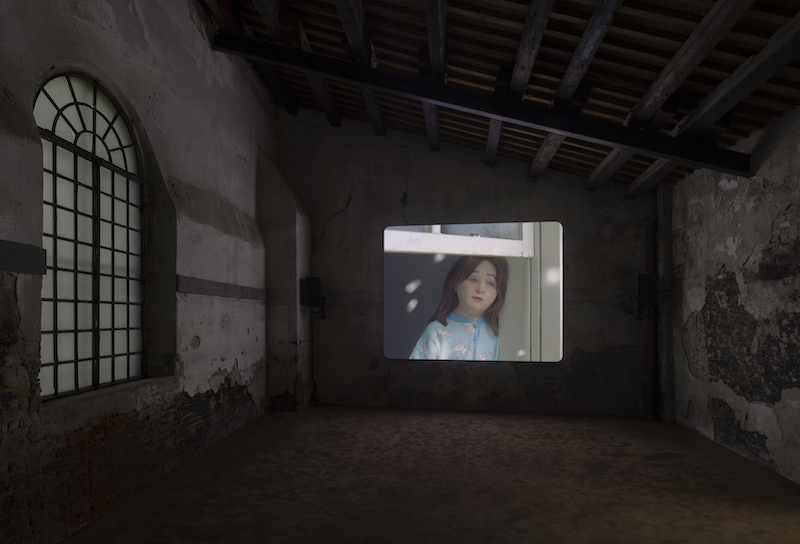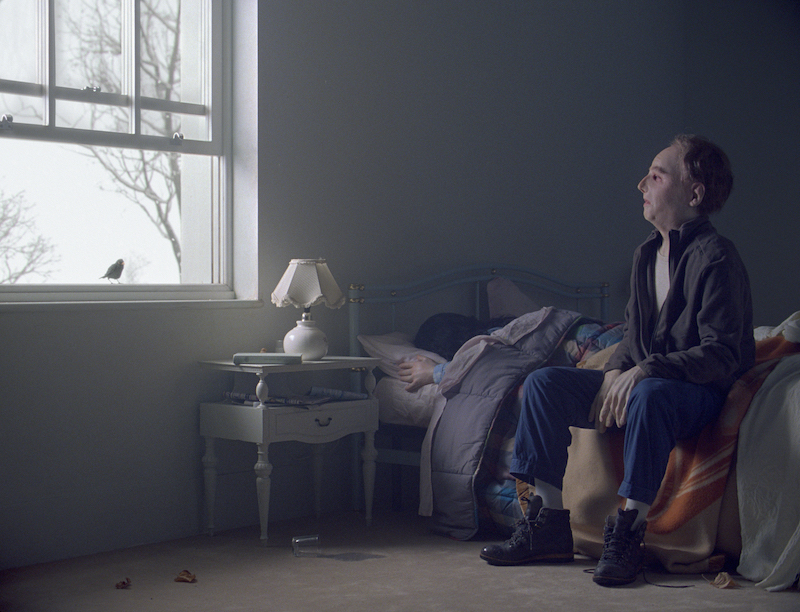
 Diego Marcon "The Parents’ Room", 2021 / Above: Film frame / Below: Installation view, 59th International Art Exhibition – La Biennale di Venezia, "The Milk of Dreams", Venice, IT © Diego Marcon. Courtesy the artist and Sadie Coles HQ, London / Photo: Andrea Rossetti / La Biennale di Venezia
Diego Marcon "The Parents’ Room", 2021 / Above: Film frame / Below: Installation view, 59th International Art Exhibition – La Biennale di Venezia, "The Milk of Dreams", Venice, IT © Diego Marcon. Courtesy the artist and Sadie Coles HQ, London / Photo: Andrea Rossetti / La Biennale di Venezia
LS: You keep your audience at a distance, I noticed that. The four actors in The Parent’s Room remain completely emotionless, when telling their story, leaving little room for empathy. What stays is a feeling of emptiness and alienation, rather than sadness and drama, which the plot would actually call for.
DM: I think that’s a correct observation. Actually, also the plot moves in this direction. I am not interested in the storytelling, The Parents’ Room doesn’t tell any story. The story is a pure fact told. It’s literal.
LS: … A fact stated clearly and without distraction. Wearing masks the characters in the film are turned into puppets of their own characters. This impression is emphasized through the technique of stop motion, a technique usually used in animation films rather than film with real actors. This subversion of the effects makes the techniques used in film very visible. Would you describe your practice as a questing of the medium itself?
DM: Indeed. I am just interested in the medium – its languages and codes – and in the structure.
 Diego Marcon "Untitled (Head falling 01)", 2015 / 16 mm film, fabric ink, permanent ink and scratches on 16 mm clear film leader, color, silent, loop of 10’’ / Film frame © Diego Marcon. Courtesy the artist and Sadie Coles HQ, London
Diego Marcon "Untitled (Head falling 01)", 2015 / 16 mm film, fabric ink, permanent ink and scratches on 16 mm clear film leader, color, silent, loop of 10’’ / Film frame © Diego Marcon. Courtesy the artist and Sadie Coles HQ, London
LS: Where do you start then? What is at the beginning of a piece like The Parents’ Room?
DM: Before The Parents’ Room, I worked with musical just for another, very short piece, and I wanted to explore more the relation of the music both with the looping structure of a film and its emotional implication for the viewer. Being focused on the genre, its language and the structure, it has been very natural to start from death as a kind of nullification of the dramaturgy, a ground zero. I wanted to make a hyper-realistic stop motion animation, but since there wasn’t much movement for the actions of the characters in the plot, I was thinking how to avoid the flickering movement typical of such a technique, which is made changing the position of the puppets for each shot, frame by frame. I thought that making human scale puppets and let them be animated from the inside by performers into a human scale set was a good solution to avoid this problem. Often very practical and formal matters end to shape very substantial aspects of the work. This underline how form and content are a whole, and that even for a movie there’s not a subject other than itself actually.
LS: It brings us back to the codes and structures of the medium, which you mentioned earlier. This brings me to my next question: You work with big production teams involving not only actors, but set designers, make-up artists, musicians, camera and production team. How would you describe your work within such a big team? Do you know them from before, or does the team change with every piece?
DM: Almost all my collaborators work with me since a while. Some from ages, like Federico Chiari, that was a fellow of mine in high school, and since the beginning he is taking care of all the sound designs and scores of my works. Other joint later, project after projects, like Valentina Bigaran, Lorenzo Cianchi, Giulia Guidi, Pierluigi Laffi, Emanuela Pigliacelli, Camilla Romeo and Diego Zuelli. Through the works, they became friends, and I try to shape every production as a moment of share and fun. This is a very important aspect for me, the core reason behind making films, videos, or projects. To live and spend time with my friends and beloved.
 Diego Marcon "Monelle", 2017 / Digital video transferred from 35 mm film, CGI animation, color, sound, loop of 13’53’’/ Film frame © Diego Marcon. Courtesy the artist and Sadie Coles HQ, London
Diego Marcon "Monelle", 2017 / Digital video transferred from 35 mm film, CGI animation, color, sound, loop of 13’53’’/ Film frame © Diego Marcon. Courtesy the artist and Sadie Coles HQ, London
LS: The setting of your films are chosen and prepared with great care. Monelle, a film you completed in 2017 is set in the dark. The characters in the film are lit up in flashes of light. They crawl through striking architecture, are dragged lifelessly across the floor, or thrown over balustrades. Violence is here set in a public building; the power lies in the hands of the state. In The Parents’ Room the setting is domestic; power, and with it the right to execute violence, lies in the hands of the father. And like in Monelle, he makes use of this power. How does the space we inhabit, move through or work in reflect the power structures executed within it?
DM: I think that everything we do is a reflection of a structure of power, and that where its strength is felt with more force and violence is in our private, in our intimacy, in our relationships. Ourselves, too, are structure of power, perpetrating it by falling apart.
LS: The Parents’ Room is currently shown in “The Milk of Dreams”, the main exhibition of the 59th Venice Biennale curated by Cecilia Alemani. The exhibition lays a focus on transformation and metamorphoses. The window in The Parents’ Room is open. Can death also be the beginning of something new, the possibility for transformation?
DM: I think so, and that it always should be, at least for the living.
LS: That is a very beautiful sentence to end with. Thank you.

